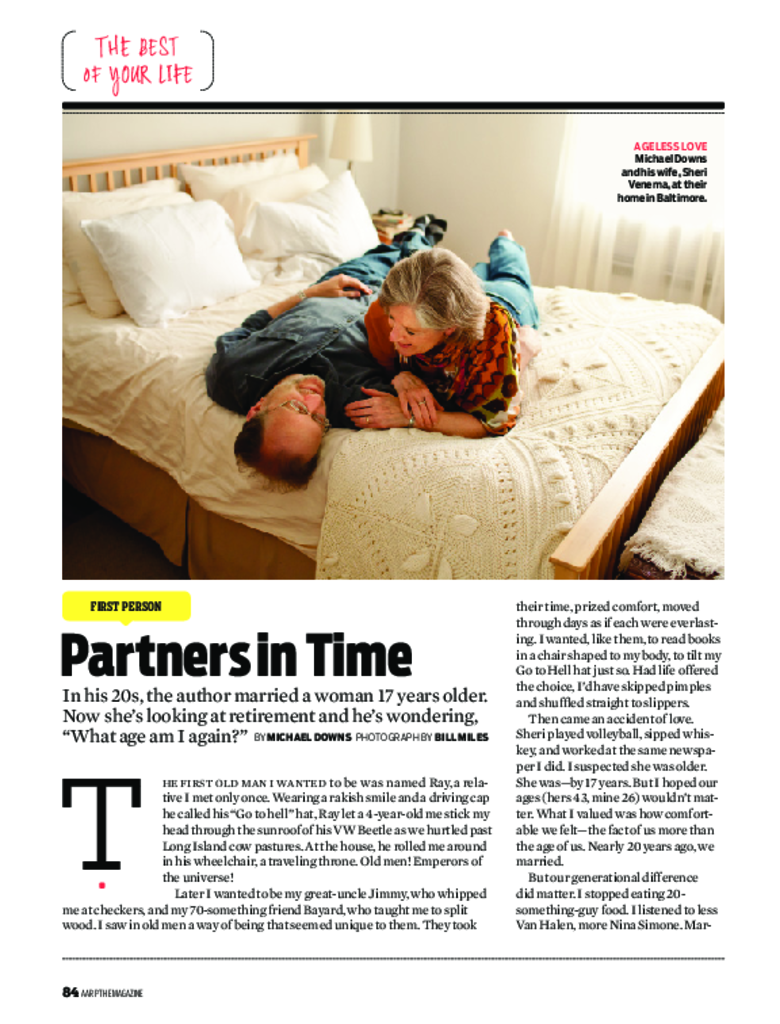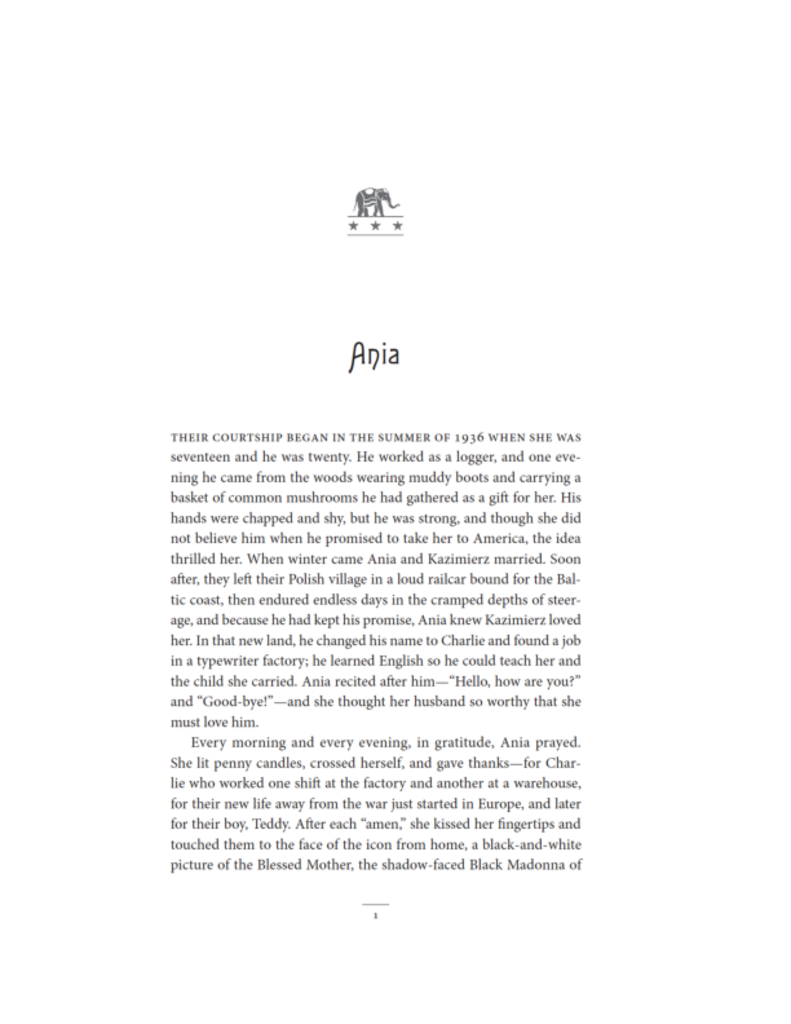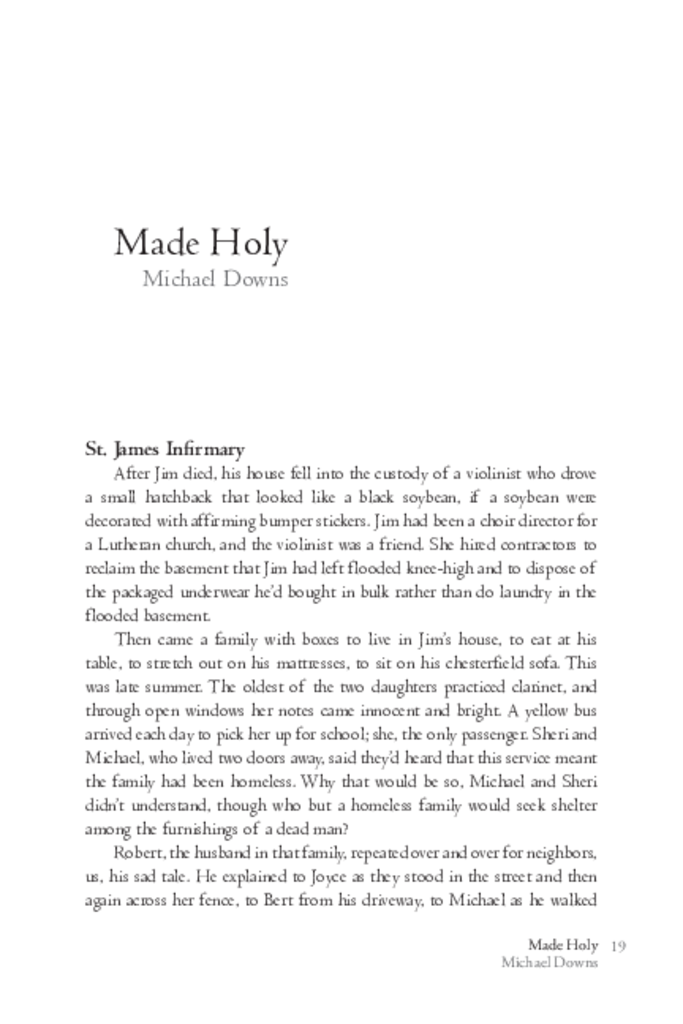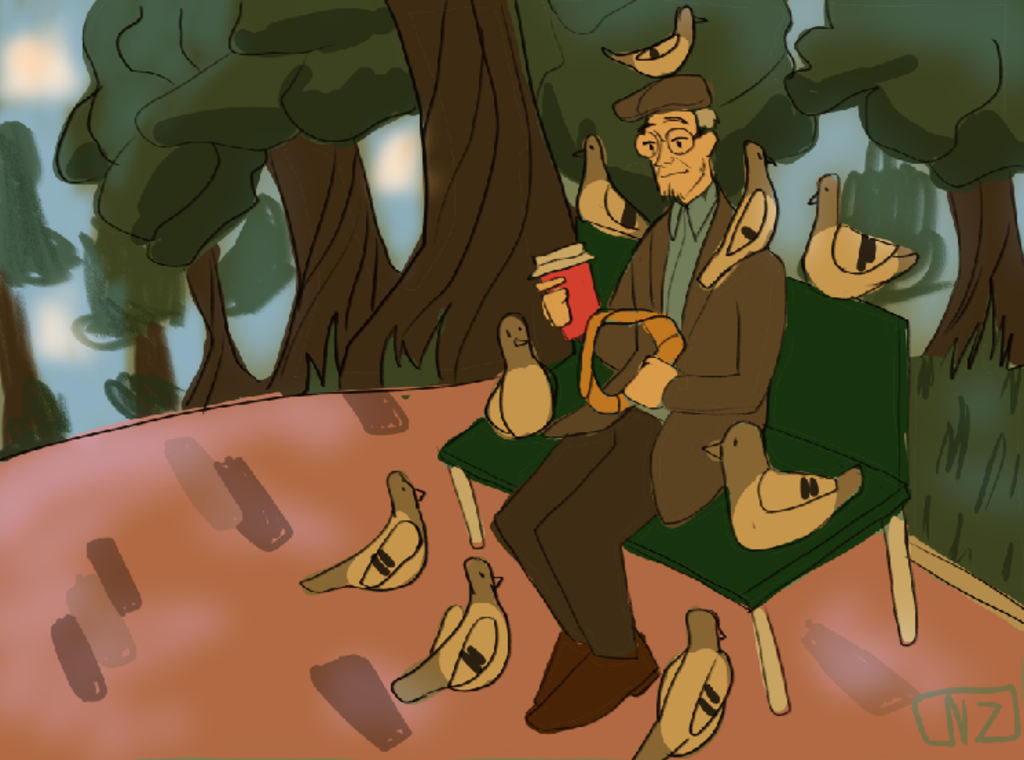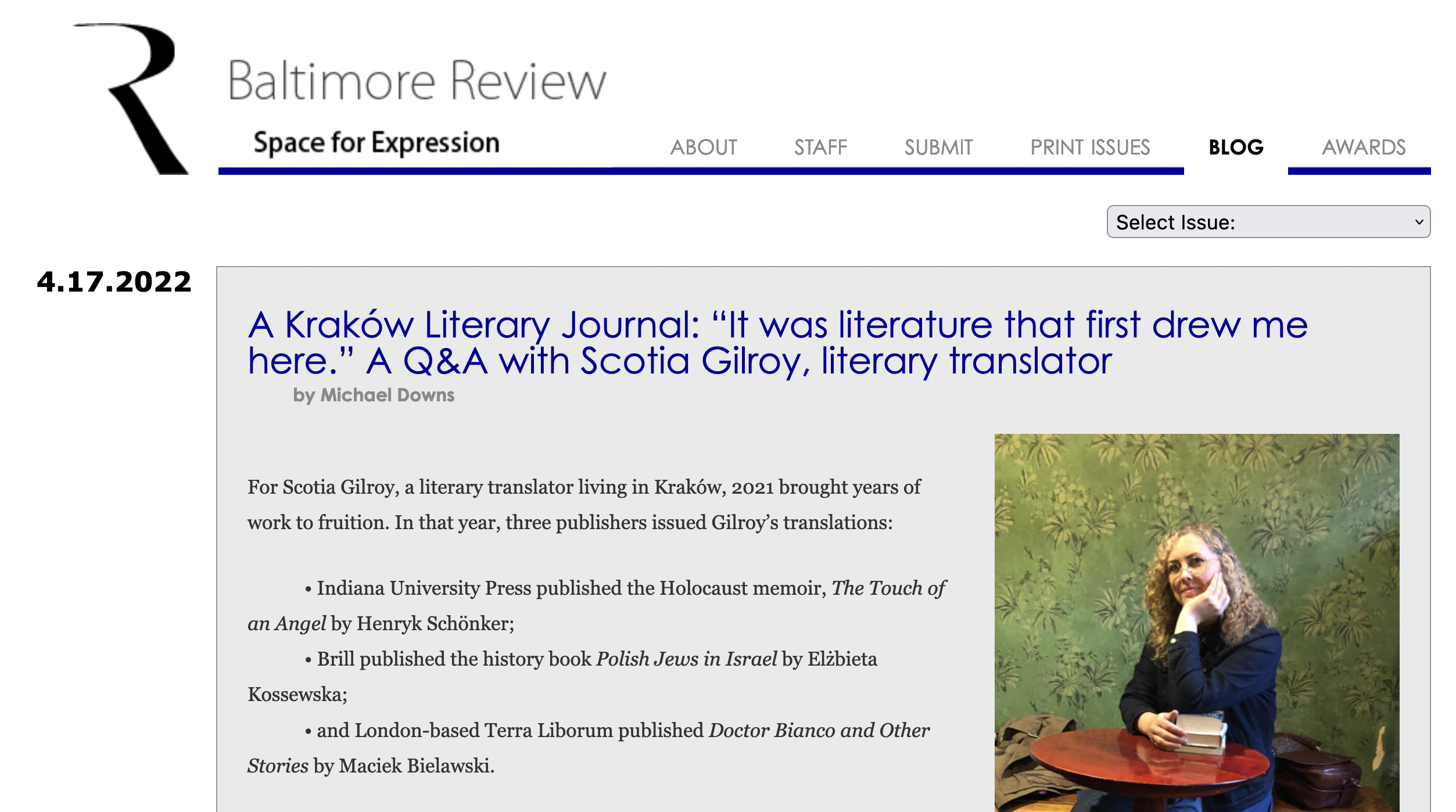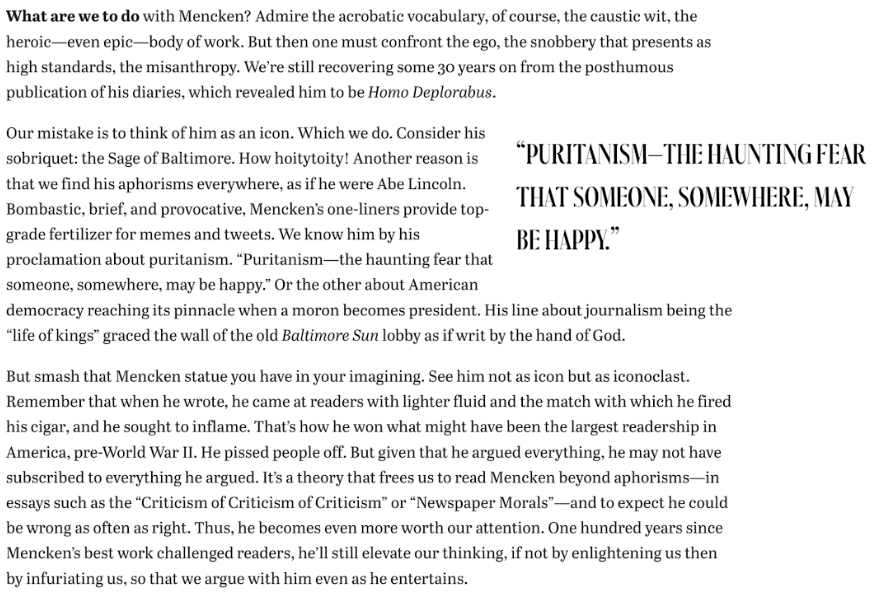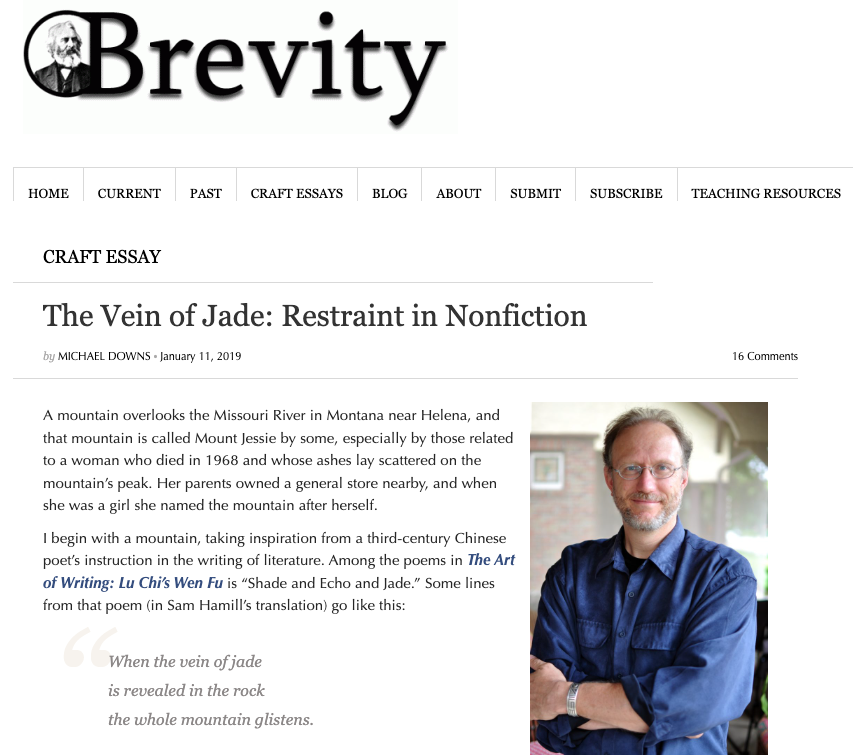Work samples
-
answer excerpt baker.pdf
That time when a member of the Velvet Underground talked me down from my horror after I'd read Lord of the Flies.
The morning when federal agents parked unmarked SUVs on my Baltimore street and took away my neighbor.
How serving as officiant at a friend's wedding caused me to dive deeply into my own ideas about God.
How visiting Clyde, Ohio, the boyhood home of famous author Sherwood Anderson, taught me about the conflicts between expectation and reality.
These and other literary nonfiction essays make up the starting point of a memoir-in-essays, with the working title "Answer When You Can." That title comes from an essay, published in The Southern Review in January 2023 and later winner of the Oran Robert Perry Burke Prize, in which I chase the origin of a letter never meant for me that nonetheless came into my life and changed it. That essay's opening appears in the image above. I invite you to click on it to read an excerpt.
-
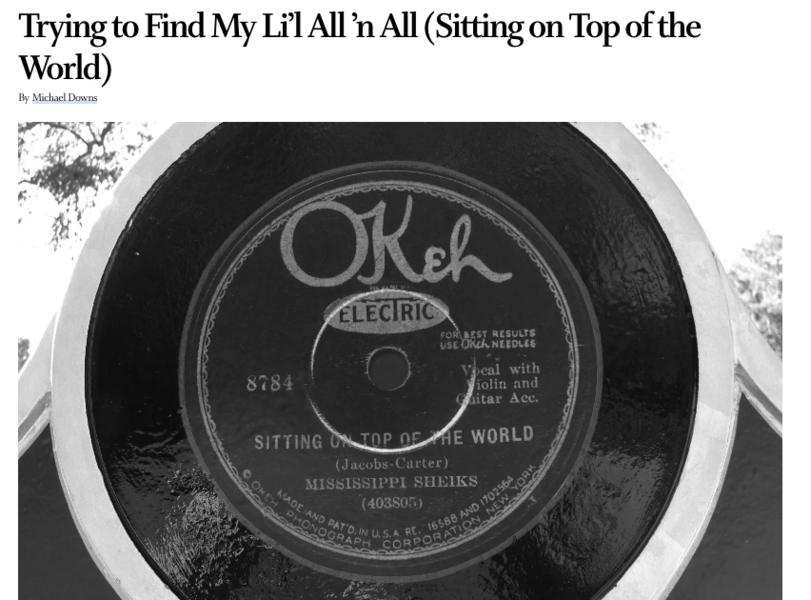 Now She's Gone, I Don't Worry: a song biography of "Sitting on Top of the World"
Now She's Gone, I Don't Worry: a song biography of "Sitting on Top of the World""What kind of song is that?" asked Lonnie Chatmon, fiddler for the Mississippi Sheiks, that moment in 1929 after his partner, Walter Vinson, played him a tune he'd just written.
One answer? “Sitting on Top of the World,” first recorded in 1930 by the Sheiks, is a shapeshifter, having been performed or recorded hundreds of times in everything from jazz to bluegrass to Texas swing, folk, and rock and gospel. In that way it's a deeply American song, one that migrates across genres, regions, and race, and meaning.What kind of song? One that for decades has held me with an inexplicable grip. One that led me to a literary memoir-essay in The Georgia Review, which in turn led me to my newest and ongoing book project: to write a song biography and tell the tale of this amazing, transcendent work of American art.
To read the essay, please see "Now She's Gone, I Don't Worry" under projects. -
YesterdayYears: short stories based on Polish legends
The Dragon under Wawel Castle; the dwarves of the Orange Revolution; pigeons who were once medieval knights; the gagged woman who haunted a king; Wojtek the Bear who fought the Axis ...
For 10 months as a Fulbright scholar in Kraków, Poland, I studied that ancient country's legends. What I wanted was to quiet the noise of the contemporary American literary scene and remind myself about primeval, essential aspects of storytelling. Our common culture's older stories–Greek myths, Biblical tales, Wild West legends–had become too familiar to shake up my understanding of fiction. But these distinctly Polish legends were new to me. This defamiliarization, combined with intense cultural study in one of the world's most literary cities, has led me to a whole new fiction-writing approach.
-
 Isn't It Fun How We Shine: A podcast of flash nonfiction
Isn't It Fun How We Shine: A podcast of flash nonfictionISN'T IT FUN HOW WE SHINE is a podcast about a neighborhood in Baltimore City's Westfield area during the Great Recession. Written as bits of flash nonfiction and interspersed with interviews and behind-the-scenes reveals, the podcast will chronicle the struggles of neighbors during an international crisis they can't control. Tender and often funny, these vignettes shape several narratives as people work to keep their neighborhood intact. A woman will go door-to-door asking for loans to pay her mortgage. A fellow with a chronic illness will give his house back to the bank. But also a man will break in through a second-floor window to rescue a dead neighbor's trapped cats. And a retiree will make a memorable cameo doing the hokey-pokey in a John Waters film.
Excerpts of the podcast's writing have been published in a variety of literary journals and been recognized as notable in Best American Essays. I invite you to visit "Isn't It Fun How We Shine" under projects to read examples of the flash nonfiction and to listen to audio.
The manuscript takes its title from graffiti spray-painted on a neighborhood dumpster: "Do Not Stop / Isn't it Fun How We Shine." The podcast is currently in production, made in collaboration with Dr. Jeremy Wexler, a musician and composer. The project began with assistance from a Rubys grant funded by the Robert W. Deutsch Foundation.
About Michael

I am a literary artist, working in fiction and nonfiction. Though I've lived all over the country, I've called Baltimore home since 2007, living first in the city and for the last two years just across the city line in Baltimore County.
I've authored three books and published individual stories and essays in some of the country's top literary journals including Kenyon Review, Ploughshares, Missouri Review, Southern Review, and Georgia Review. A one-time newspaper reporter, I shifted… more
Answer When You Can: a memoir in essays
That time when a member of the Velvet Underground talked 13-year-old me down from my horror after I'd read Lord of the Flies.
The morning when federal agents parked unmarked SUVs on my Baltimore street and took away my neighbor.
How serving as officiant at a friend's wedding caused me to dive deeply into my own ideas about God.
How visiting Clyde, Ohio, the boyhood home of famous author Sherwood Anderson, taught me about the conflicts between expectation and reality.
What comes of a May-December romance, when that romance is 28-year-old me marrying a 45-year-old woman.
These and other literary nonfiction essays make up the foundation of a memoir-in-essays, with the working title "Answer When You Can." That title comes from an essay, published in The Southern Review in January 2023 and later winner of the Oran Robert Perry Burke Prize, in which I chase the origin of a letter never meant for me that nonetheless came into my life and changed it. It is a book about the unexpected, the surprising moments that turn you around and point you in a different direction.
The book is about half completed.
-
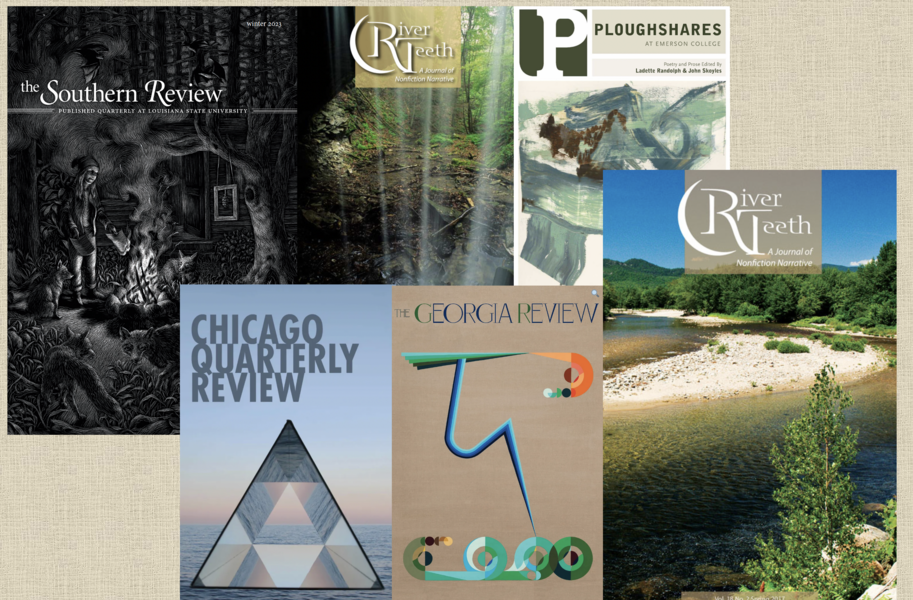 Where essays have appeared
Where essays have appearedThe foundation of this book of essays is constructed of work that has appeared in some of the country's top literary journals, including these.
-
"For Anyone Who Ever Played a Part"
This essay, originally published in the journal Ploughshares, involves a peculiar moment of personal history involving Sterling Morrison, a relative by marriage who had played guitar as a founding member of the Velvet Underground, one of rock's most influential bands. It involves a long-distance phone call that followed my reading Lord of the Flies. Gripped by "tied-down terror," (the words of the novel's author, William Golding), I listened as Sterling talked me through the book and through the consolations and challenges of art.
-
The Reverend
This spiritual journey began, as spiritual journeys do, with a question.
“I know it’s a lot to ask,” Courtney wrote, “but we would be honored if you’d consider becoming a fake minister and marrying us.”
So I did. But it's not easy for a former (devoted) altar boy to become a fake minister, no matter how far he's fallen away from a religion. So what started as a bit of a joke became something else: transformative. It became a revelation that God and I were not yet finished with each other. -
Winesburg Days
Sherwood Anderson wrote one of my favorite books: Winesburg, Ohio. It was only natural then, that in the midst of a cross country trip I wanted to veer away to the town where he was raised and which inspired the book. But Clyde turned out not to care much that Sherwood Anderson lived there. This disappointed me. But it was also the beginning of how I came to understand the ways in which the town was different than the one Sherwood Anderson depicted but also so very much like it.
This essay was published in the Chicago Quarterly Review.
Now She's Gone, I Don't Worry: A song biography of "Sitting on Top of the World"
"What kind of song is that?" asked Lonnie Chatmon, fiddler for the Mississippi Sheiks, that moment in 1929 after his partner, Walter Vinson, played him a tune he'd just written.
One answer? “Sitting on Top of the World,” first recorded in 1930 by the Sheiks, is a shapeshifter, having been performed or recorded hundreds of times in everything from jazz to bluegrass to Texas swing, folk, rock, and gospel. In that way it's a deeply American song, one that migrates across genres, regions, race, and meaning. What kind of song? One that for decades has held me with an inexplicable grip. One that led me to a literary memoir-essay in The Georgia Review, which in turn led me to my newest and ongoing book project: to write a song biography and tell the tale of this amazing, transcendent work of American art.
-
Essay: Trying to Find My Li'l All 'n' All (Georgia Review)
This essay, published in The Georgia Review, represents the start of my writing about "Sitting on Top of the World." In the essay, I embark on a road trip from Baltimore to Texas, mixing my need to learn about the song with my need to be a good son to my chronically ill mother and to my father, who is her primary caretaker.
"My parents, say my brother and sister, always wear their best faces when I visit. I'm the oldest, the prodigal who left home and never moved back. For me, Mom and Dad smile and straighten up. If not atop the world, they're resting on pillowed recliners. But I know. We all know."
I invite you also to read the essay online at the Georgia Review's website.
-
 Sitting on Top of the World: performers
Sitting on Top of the World: performersThis song biography of "Sitting on Top of the World" requires research of all sorts, including journalistic. My journalism background–including as a newspaper reporter for more than a decade–has served me as I've worked on the book proposal. I've interviewed performers who have recorded versions of "Sitting on Top of the World." In this image from Zoom, I talk with singer-songwriter Chris Smither, who released a seminal version of the song in 1984 and then, in his 70s, recorded a more mature and complex version for his 2018 album, CALL ME LUCKY.
-
 "Sitting on Top of the World": documents
"Sitting on Top of the World": documentsThis song biography requires me to do deep dives into documents. To complete the book proposal, I've read theses and dissertations about the blues and performers who have recorded "Sitting on Top of the World," listened to hours of audio from the 1972 Smithsonian Festival of American Folk Life, and–with assistance from a folklorist who worked with Walter Vinson, who wrote the song–dug into personal and professional documents pertaining to Vinson and the Mississippi Sheiks. This image shows a copyright sheet naming Walter Vinson and his partner Lonnie Chatmon as authors of the song. This documentation served in Walter Vinson's late-in-life battle to win back rights and royalties stolen from him when others claimed authorship of "Sitting on Top of the World."
-
 Playlist: Sitting on Top of the World
Playlist: Sitting on Top of the WorldPerformers have recorded hundreds of versions of "Sitting on Top of the World" in a variety of genres. I've collected more than 50 versions by performers who are famous or obscure, from the earliest days of recorded blues to soundtrack versions to go with contemporary TV shows. I invite you to listen to the variety and nuance of the recordings. Click this link to go to Spotify where I've curated a small collection of versions.
Book publications: fiction and nonfiction
My three books show a range of subject and genre.
First came HOUSE OF GOOD HOPE: A PROMISE FOR A BROKEN CITY, which combined literary journalism and memoir to tell the story of five young men who pledged their lives to their troubled hometown, which was also my hometown.
Then: THE GREATEST SHOW: STORIES, a collection of linked short stories using fiction to explore the repercussions of the very real and historic 1944 fire that engulfed a circus tent and killed 168 people of the thousands who attended that day's performance.
Finally, a novel: THE STRANGE AND TRUE TALE OF HORACE WELLS, SURGEON DENTIST, which mined the gaps in the historical record to imagine the motivations and mysteries behind the troubled life of the man who discovered anesthesia.
Yet the books also share commonalities: A concern with community, in-depth research, a fascination with history and what it reveals about us now, and affection for people both real and imagined.
"... a marvelously talented writer."
– Foreword magazine
-
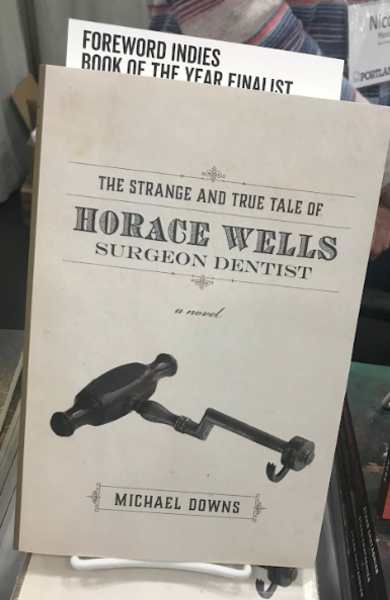 The Strange and True Tale of Horace Wells, Surgeon Dentist
The Strange and True Tale of Horace Wells, Surgeon DentistMoving through 19th-century New England to Paris and back again, THE STRANGE AND TRUE TALE OF HORACE WELLS, SURGEON DENTIST imagines the sacrifices and struggles of the man widely credited with discovering anesthesia. It is a love story but also a story of what love can't redeem: of narcotic dreams and waking insanity; of pain's destruction and what pains can never be eased. A novel that resonates with our contemporary struggles involving pain and the substances that numb it.
Finalist, historical ficiton, Foreword INDIES Book of the Year Award; Finalist for the Phillip H. McMath Post-Publication Award for the Novel.
"Downs tells a fascinating story in skilled, often elegant prose, and he treats all his characters with great sympathy." – Los Angeles Review of Books
Available for Purchase -
excerpt: The Strange and True Tale of Horace Wells
In this excerpt, Horace Wells subjects himself to nitrous oxide while his tooth is pulled, a moment that introduced anesthesia and changed the world.
Available for Purchase -
 with readers of The Strange and True Tale of Horace Wells
with readers of The Strange and True Tale of Horace WellsA foundation invited me to Connecticut where Horace Wells lived to read from the book and answer questions from these lovely people.
-
 At the grave of Horace Wells and his family
At the grave of Horace Wells and his familyResearch is central to my work – even my fiction writing. That research includes books and the internet but goes far beyond those. For example, to better understand my subject in the Horace Wells novel, I spent time in Hartford, CT, visiting places where he lived and worked, examining his daybook and holding his death mask, and spending time at the Cedar Hill cemetery where he and his family are buried. I even asked my dentist, who needed to fill a cavity for me, if he would give me nitrous oxide, the gas that Horace Wells used to first experiment with anesthesia, so I could better understand its effects.
-
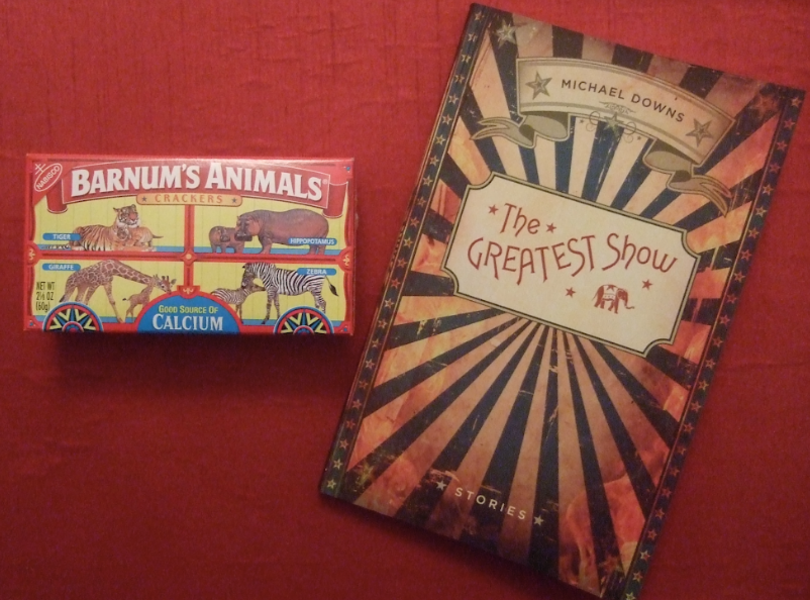 The Greatest Show: Stories
The Greatest Show: StoriesInspired by the true-life Hartford Circus Fire of 1944, this collection of ten linked stories explores the way disaster reshapes a community over decades. Stories from THE GREATEST SHOW appeared in The Georgia Review, The Missouri Review, the Kenyon Review, Gettysburg Review, and other journals. Three of the stories were recognized as distinguished in the Best American Short Stories series.
A finalist for the Paterson Prize in Fiction.
Foreword magazine: ''an auspicious fiction debut from a marvelously talented writer"
The Rumpus: "intricately woven"
Shenandoah Review: "beautifully written. Not a word out of place."
West Branch Wired: "These are quiet stories, in the tradition of Winesburg, Ohio, ... [with] the dramatic weight and complexity of a novel."
Colorado Review: "gorgeously captures the sweep of ordinary lives made remarkable by a tragic twist of fate."Available for Purchase -
Ania: a short story
This story, originally published in The Georgia Review, opens the collection, THE GREATEST SHOW. It tells the story of an immigrant housekeeper in Hartford, Connecticut, who steals tickets from her employer so she can take her son to the circus and who is therefore confronted with one of the worst fire disasters in American history.
"Ania" received recognition as notable in the Best American Short Stories series. It was the manuscript I entered when I won a literature fellowship from the National Endowment for the Arts.
-
 House of Good Hope: A Promise for a Broken City
House of Good Hope: A Promise for a Broken CityHOUSE OF GOOD HOPE: A PROMISE FOR A BROKEN CITY combines reportage and memoir to tells the true story of five remarkable and talented young men from Hartford, Connecticut, who pledge their lives to their hometown and who find that promise not always easy to keep.
Winner: River Teeth Prize for Literary Nonfiction
Finalist: Connecticut Book Award in Biography and Memoir.
The cover for HOUSE OF GOOD HOPE: A PROMISE FOR A BROKEN CITY, is detail from a quilt called "All that Amazing Jazz," by Hartford, Connecticut, quilt artist Ed Johnetta Miller. Photo by John Ryan.Available for Purchase -
excerpt: House of Good Hope
An excerpt featuring the opening pages of HOUSE OF GOOD HOPE.
"... a beautiful book, filled with the poignant bittersweet of hope and loss." – Buzz Bissinger, author of Friday Night Lights
Publishers Weekly: Combining a reporter's eye for detail, the breathless narrative rush of an action movie and the generous heart of a hometown boy desperately trying to make sense of a place gone terribly wrong, Downs examines the social and economic disintegration of Hartford, Conn., in the 1990s through the coming-of-age of five African-American teenage boys.
The Hartford Courant: "... a lavish love letter to Connecticut’s capital city." -
 Hollywood''s Team: a collaboration
Hollywood''s Team: a collaborationSelected by the Athletic sports journalism site as the one book to read about the Los Angeles Rams, HOLLYWOOD's TEAM is part history of Los Angeles, the NFL, and also part biography. It was a pleasure to assist author Jim Hock in his work to tell the story of his father, an offensive lineman who played for the Rams in the early 1950s.
"A winning new book..." – David Davis, LAObserved
Isn't It Fun How We Shine: a podcast featuring flash nonfiction set in Baltimore
ISN'T IT FUN HOW WE SHINE is a podcast about a neighborhood in Baltimore City's Westfield area during the Great Recession. Written as bits of flash nonfiction and interspersed with interviews and behind-the-scenes reveals, the podcast will chronicle the struggles of neighbors during an international crisis they can't control.
Excerpts of the podcast's writing have been published in a variety of literary journals and been recognized as notable in Best American Essays.
“ISN’T IT FUN HOW WE SHINE christens a new genre—the neighborhood memoir—introducing us to a range of characters explored with affection and humor. I found myself wishing I, too, lived on Baltimore’s Sefton Avenue. These sixty-some short-form nonfiction pieces, wryly aware of the passage of time, offer profound insight into human nature in sentences both graceful and musical. Spending time in Michael Downs’ neighborhood returns me to my own with fresh and inspired eyes.” Beth Ann Fennelly, author of Heating and Cooling: Micro-memoirs and former poet laureate of Mississippi.
The manuscript takes its title from graffiti spray-painted on a neighborhood dumpster: "Do Not Stop / Isn't it Fun How We Shine." The podcast is currently in production, made in collaboration with Dr. Jeremy Wexler, a musician and composer who has recorded my narration. The project began with assistance from a Rubys grant funded by the Robert W. Deutsch Foundation.
-
Neighbors Gathered
"Neighbors Gathered" is an audio version of a collage essay that first appeared in Alaska Quarterly Review and received notable distinction in the Best American Essays series. By collage essay, I mean a single work comprised of several individual flash nonfictions. One might also think of the work, visually, as a quilt with separate swatches that make the whole.
The flash nonfictions will also appear in the podcast. The image accompanying this recording is of the dumpster that gives the podcast its title.
The recordings is about 15 minutes. It was engineered and edited by Dr. Jeremy Wexler. As author, I offer the narration.
-
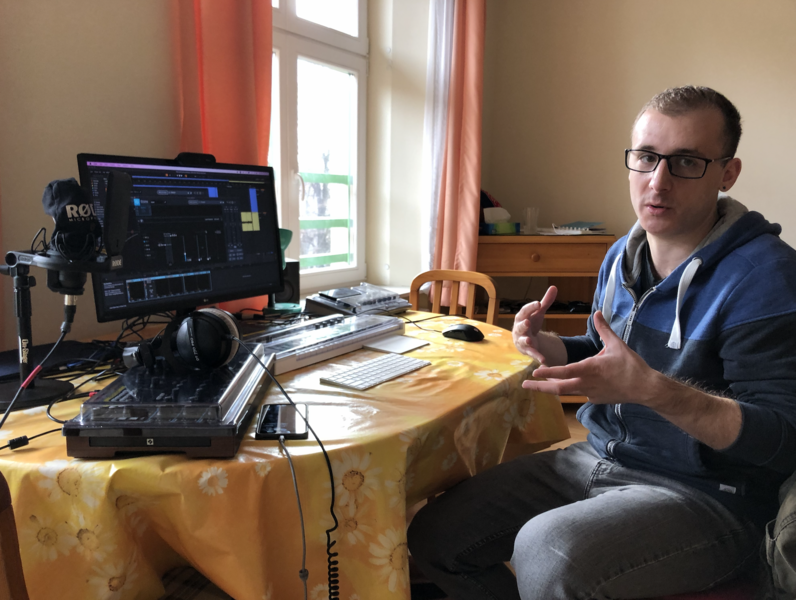 Dr. Jeremy Wexler, recording Isn't It Fun How We Shine
Dr. Jeremy Wexler, recording Isn't It Fun How We ShineDr. Jeremy Wexler is a musician and composer based in New York. I invite you to learn more about him by visiting his website (click here).
Jeremy and I met in Kraków, Poland where we both worked through the Fulbright program. In this image, he explains to me the functions of his recording equipment and how he'll edit the recordings of me reading ISN'T IT FUN HOW WE SHINE. We've recorded the entire manuscript, which will accompany the podcast as an audio book. -
Jim at 2 am.: Something Like Opera
"Jim at 2 a.m.: Something Like Opera" is a collage essay of flash nonfictions, all having to do with a Sefton Avenue neighbor whose tormented life and torment of his neighbors ended tragically.
The collage essay first appeared in The Southern Review, which also published a recorded version, performed by me, the author, and my wife, Sheri Venema. This represents an early foray into recording, so the quality isn't what I'd like. But it still offers a sense of the spirit of the podcast.
All of the flash nonfictions included here are part of the podcast. -
 The Morning After His Family Buried Freddie Gray
The Morning After His Family Buried Freddie Gray"The Morning After His Family Buried Freddie Gray" was written in response to the Baltimore Uprising of 2015. American Short Fiction, a literary journal, asked several Baltimore writers to respond to the event, and this work was my offering. It was also my first foray into flash nonfiction, and it suggested to me that the form would be well suited to tell the tale of my neighborhood over the last several years of the Great Recesssion.
"The Morning After His Familly Buried Freddie Gray" is included in the podcast. I invite you to read the original text via Lit Hub, a nationally recognized website dedicated to literature, by clicking here.
-
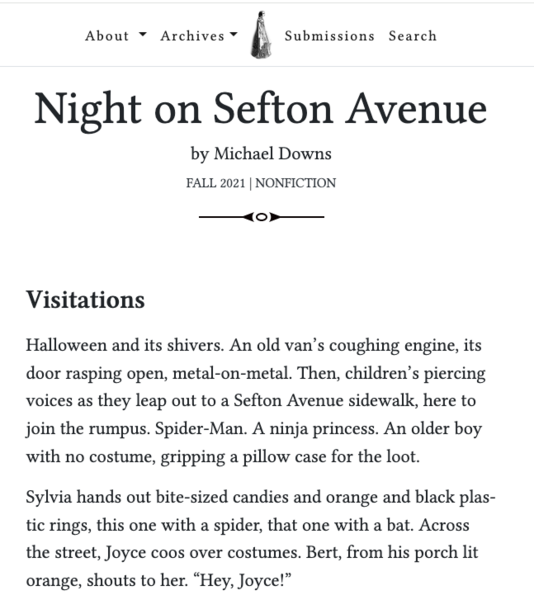 Night on Sefton Avenue
Night on Sefton AvenueIndividual flash nonfiction essays from ISN'T IT FUN HOW WE SHINE have been published in a variety of literary journals, including Alaska Quarterly Review, Sport Literate, RiverTeeth, The Southern Review, Baltimore Review, Literary Hub, and Ligeia.
To read the two essays published by Ligeia, I invite you to click here. Combined as "Night on Sefton Avenue" they tell one story of a strange Halloween visitor and another of a house haunted by a murder-suicide that happened there some 70 years before.
To read the two essays published by Baltimore Review, I invite you to click here. Open House is about a woman who moved from Big Sky country to Sefton Avenue and who longs for wide open spaces. Crossword Puzzles depicts a character kept awake by obsessions over money trouble.
-
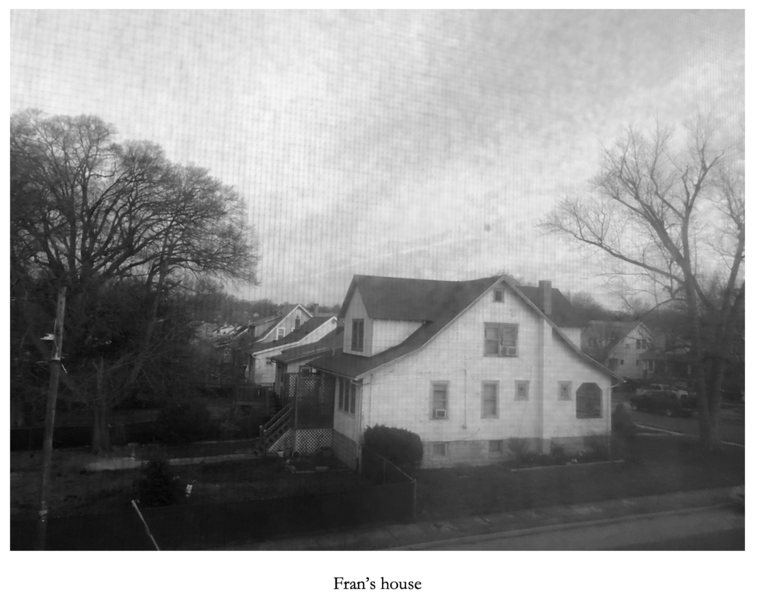 November on Sefton Avenue
November on Sefton AvenueTo set the scene, here is a view of a house on Sefton Avenue.
YesterdayYears: short fiction inspired by Central European legends
My projects for this portfolio include some in the making, some that are finished, and this one, which is just starting. Though, it seems I've been traveling toward this project for many years. I first heard a Polish legend some six years ago from a tour guide during a three-day 109-mile bicycle trip that took our party from medieval castle to medieval castle. The legend of the princess and the hawk and the ghost thrilled me, strange and intense as it was, and thus began my quest to dig deeply into Poland's literary culture and thereby reinvent my own work.
In June 2022, I finished a 10-month stint in Kraków, Poland as a Fulbright scholar. I studied that ancient country's legends but I also embraced the cultural exchange that is a hallmark of the Fulbright program. I spoke to university classes and clubs and visited a rural town's high school to speak with students about education in America, and immersed myself in the rich literature Polish writers have produced. I practiced speaking Polish. My time in Poland coincided with the beginning of the war in Ukraine, and that, too, became part of my experience. In small ways, I tried to help the cause, including by helping to feed Ukrainians at the train station.
Now, back home, I've started drafting short stories inspired by Polish legends. These aren't transcriptions of Polish tales into some American vision, but instead wholly new work infused with what I learned over ten months living in a land where–as one writer once described–history punches like a fist up through the paving stones. None are ready to share yet, but I'm happy to give you a glimpse into this project and what fuels it.
-
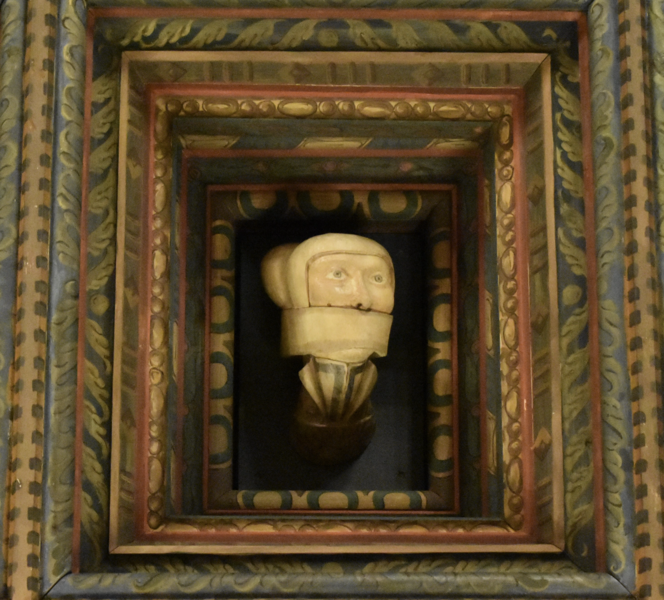 The Gagged Woman
The Gagged WomanThis image depicts the Gagged Woman, who has become a Polish legend. The actual carving, polished and painted, can be found with dozens of other faces across the ceiling of one of the royal rooms at Wawel Castle. The legend tells of how the carving spoke to a king during a trial saying, "King, decide justly." Tormented by the brevity and mystery of her remark, he ordered the carving to be gagged.
-
The Gage Rule: short fiction
These pages are an excerpt of a working draft in which I use the legend of the Gagged Woman of Wawel Castle to fashion my own short story. The legend pricked in me a desire to explore the interactions of power, speech, and silencing. I decided to do this through the testimony of people to a documentarian who is making a film about a crime.
-
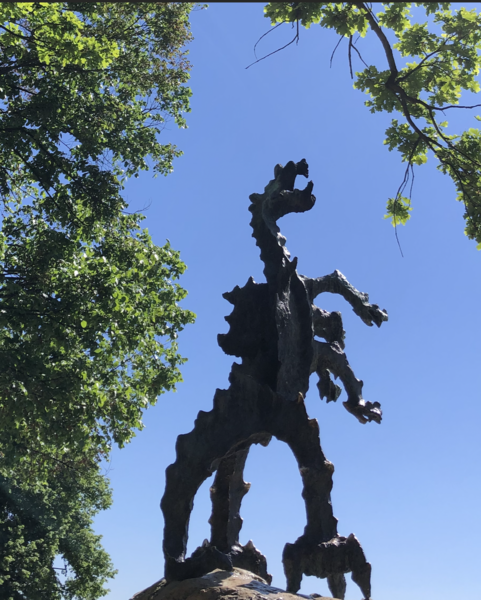 The dragon of Wawel Castle
The dragon of Wawel CastleThe dragon that lived under Wawel Castle tormented medieval Kraków until the king at last turned to a boy, a shoemaker's apprentice, who claimed he could get rid of the threat. The king sent him to face the monster that had already destroyed the king's strongest and most capable knights. This legend troubles me, because though it is a tale similar to David and Goliath and other such, it made clear to me that the adults in this story are impotent and willing to send a child to certain death as if he might fix what they can't.
The legend inspired my story, "Marasek Middle," an excerpt of which is found in my work samples. -
Writer with pigeons (who may also be knights)
When I told students in Poland that I often did my writing on park benches and that I was interested in a Polish legend that tells how medieval knights became pigeons, one student responded by creating this image of me. On a park bench. Communing with pigeons. I'm eager to see where this legend takes my imagination.
Thanks to Natalia Zyla, who made the drawing. -
 A Kraków Literary Journal for Baltimore Review
A Kraków Literary Journal for Baltimore ReviewIn an effort to create an exchange of literary culture, I wrote six blog posts for The Baltimore Review, where I serve on the board of directors. My blog posts, all under the title of "A Kraków Literary Journal," introduced readers to a poet, a translator, and to several significant aspects of literary life in Kraków including the city's year-long celebration of the science fiction writer, Stanisław Lem. I invite you to click the links below to read the blog posts.
Meeting with Writers and Poets in Kraków’s Literary Park
Reading a Rainbow
Notes on The Year of Lem
A Street of Verse
“The Body is the Source and the End.” Q&A with Michał Choiński, poet and scholar
“It was literature that first drew me here.” A Q&A with Scotia Gilroy, literary translator
-
 Ukraine
UkraineThe night Putin started his mad war, my wife and I joined a shoulder-to-shoulder crowd in a plaza outside the Russian consulate to protest. Within weeks, Kraków added about 150,000 Ukrainians to its population, which is generally about the size of Baltimore's. Over the next several weeks, we organized donations and other assistance efforts, volunteered to feed refugees, gave money, and generally did whatever we could to support the Ukrainians. We only wish we could have done more.
Friends in America requested news, so I regularly took pictures and offered narratives via social media, telling about the effects of the war in a city less than a three-hour drive from the Ukrainian border. This image, created by an artist to describe the plight of children forced to flee Ukraine, appeared on a Kraków doorway just a couple of blocks from our apartment. -
 In Kraków, Michael Downs and His Students Talk Poetry and War
In Kraków, Michael Downs and His Students Talk Poetry and WarWhen I agreed to teach what was likely the first-ever creative writing course offered by Jagiellonian University (founded 1364), I had no idea what a profound first class session we'd have. Four days after Putin's invasion of Ukraine, I met with students on a park bench to learn from them how the war had shaken their understanding of Europe and also to try to find a reason to write and read when lives were at stake in a country next door.
Baltimore Fishbowl was kind enough to publish my essay on that moment. I invite you to click here to read it.
Dark Agnès: The Head of St. Denis
It's never too late accomplish the dreams of youth. As a teen, when I collected comic books, I dreamed of writing my own. In 2024, at a more advanced age, that dream came true when Dark Agnès: The Head of St. Denis debuted. With my script and art by Piotr Kowalski of Warsaw, the story came to life in the pages of a black-and-white magazine called The Savage Sword of Conan (No. 6, January 2025).
Dark Agnès, like her more famous barbaric counterpart, is the creation of Robert E. Howard, one of the most prolific pulp writers of pre-WWII America. But while Conan roams an invented world during a mythical "Hyborian Age," Dark Agnès adventures in early 16th-century France. Moreover, Howard's French swordswoman is a feminist figure who stabbed her betrothed rather than acquiesce to an arranged marriage.
Writing a comic book script demanded I learn new skills, including working with an artist and marrying the words the art, and a new format (comic book scripts are much like film scripts, only with their own requirements).
Writing about Agnès appeals to me because hers are the only Howard stories written in first person. Moreover, they are told by an Agnès who is much older than the young swordswoman she describes. Thus, my script is really about two versions of Dark Agnès. One is young, illiterate, and recently escaped from a stultifying rural village. The other is older, more sophisticated, clearly literate, and wise with age. That tension fascinates me.
-
 Dark Agnès splash page
Dark Agnès splash page -
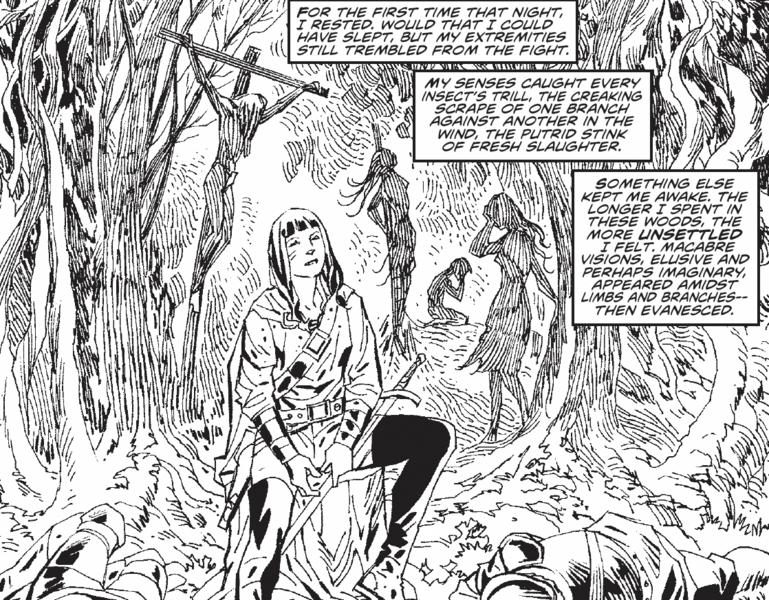 The Haunted Woods
The Haunted WoodsA panel from the story. Agnès rests after besting five warriors and begins to sense that the woods around her is haunted.
-
 REPENT!
REPENT!An excerpt from a panel, showing how the third-person narrative at a remove allowed me to write two characters: older Agnès narrating the lived experience of younger Agnès.
Menckeniana: cultural criticism involving H.L. Mencken
My interest in the Sage of Baltimore, H.L. Mencken, confuses even me. I owe him nothing. I only started to read his work in the last few years. Though I've lived in Baltimore–his lifelong home as a columnist and editor for the Baltimore Sun–and though I've worked as a newspaper journalist, Mencken was not part of my life until 2021 when the Pratt Library invited me to give the annual Mencken Memorial Lecture.
Since then, I've continued my engagement with Mencken–once called the most powerful private person in the United States–by writing about him for both Baltimore Magazine and the Los Angeles Review of Books. What keeps me coming back to this iconoclast, admired for his skepticism and wit yet excoriated for racist and anti-Semitic writings? Maybe this. That to read Mencken is to wrestle with the United States and American culture–and not just as it was in the 1920s and '30s when Mencken was in his prime.
To wrestle with Mencken is to wrestle with the country and the culture as it is today.
-
Mencken Memorial Lecture, 2021
In 2021, when I gave the Mencken Memorial Lecture at the Enoch Pratt Free Library, it was to a nearly empty room: just a few friends in masks. But the lecture also went out to several hundred others who watched the video live-streamed on Facebook. In the talk, titled "The Babelobabuli: Notes on Mencken and Today's Muddled Topography of Literary Journals," I considered what Mencken suggests to us as readers and writers about navigating the thousands of literary journals published today online and in print. I quoted Mencken, saying that "good work is always done in the middle ground, between the theories," a line that explains our time when writers are more than ever working in a wide-open literary landscape, one that allows for the creation of new and exciting work.
The talk was later published as an essay in "Menckeniana: A magazine about all things Mencken."
The talk itself begins at the 2:30 mark in the video.
-
 Menckeniana cover
Menckeniana coverThe Fall 2022 issue of Menckeniana, No. 227, was the last to be published by the Enoch Pratt Free Library. It also included my essay, "The Babelobabuli," based on my talk given for the 2021 Mencken Memorial Day Lecture.
-
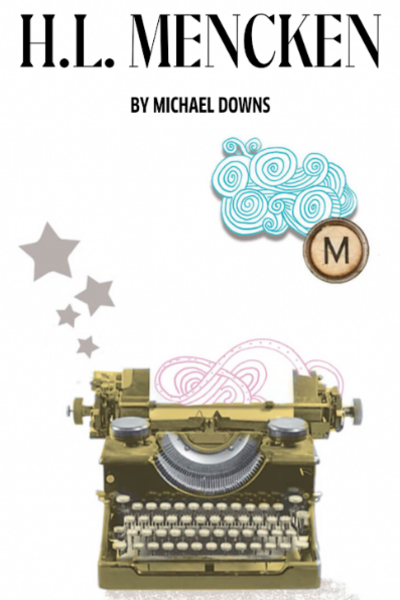 Baltimore Magazine and Mencken
Baltimore Magazine and MenckenBaltimore Magazine published "The City that Writes," short features on 13 dead Baltimore writers, written by 13 living ones. The magazine asked me to write about H.L. Mencken, the curmudgeonly Sage of Baltimore.
-
 Baltimore magazine: What are we to do with Mencken?
Baltimore magazine: What are we to do with Mencken?"What are we to do with Mencken?" became the question that fueled my writing about him for Baltimore Magazine, and which continues to fuel my interest in H.L. Mencken, an important and controversial figure in his time and now.
-
 Los Angeles Review of Books
Los Angeles Review of BooksThe Los Angeles Review of Books is scheduled to publish my 3,700-word essay on Mencken on his birthday this year, January 29. "The Last of the Menckenians" considers the dwindling numbers of the Mencken Society and explores Mencken's value in today's literary culture.
From the essay:
"Aficionados don't read Mencken because they expect to agree with him. They read him for the adrenaline jolt. That jolt hits because Mencken delivers scorn with wit and reason. He vivifies his 21st-century fans as he has ever done for readers. 'He calls you a swine, and an imbecile,' wrote critic Walter Lippmann in 1926, 'and he increases your will to live.' "
Literary Citizenship and Community
In 2023, as director of the Baltimore Writers' Conference, I invited two people affiliated with important literary nonprofits to speak for a session I called "Literary Citizenship." After all, the conference, which drew some 120 writers and aspiring writers, was itself a great gathering of literary citizens. Literary citizenship and the nurturing of literary community have long been hallmarks of my work as a writer. Through teaching, volunteering, and sharing my own ideas and work in panel presentations and readings, I've encourages literary writing and reading. Most recently, I've done this through teaching at the Goucher College Young Writers' Camp, directing the Baltimore Writers' Conference, and serving on the boards of two literary nonprofits (The Baltimore Review; Good Contrivance Farm Writing Retreat).
-
 Talking plot at Goucher College's Young Writers' Camp
Talking plot at Goucher College's Young Writers' CampIn summer 2023, I was invited to spend an afternoon talking about literary writing with high school students at the Goucher College Young Writers' Camp. After a get-to-know-you session featuring a Nerf ball and conversation about writing in general, we took a look at the essentials of plot by riffing off Kurt Vonnegut's definition: A character wants something; the character can't have it; what happens next?
Photo by Adan Rodriguez -
 Resuscitating the Baltimore Writers' Conference
Resuscitating the Baltimore Writers' ConferenceAfter a four-year pandemic hiatus, the Baltimore Writers' Conference returned in 2023. This was the third time I've directed the conference, which is organized and sponsored by the professional writing graduate program at Towson University where I have taught.
The one-day conference offered 16 sessions plus a keynote address. Session subjects connected writers and aspiring writers with podcasters, a literary agent, writers of fiction and nonfiction, poets, a screenwriter, a magazine journalist, a web comic creator, a literary agent and two editors with publishing houses. We also included a session on serving as a literary citizen, led by Jake Ricafrente from the board of Kundiman, a national nonprofit dedicated to writers and readers of Asian American literature.
With a literary fair populated by journals and literary nonprofits, the conference assembled some 120 people for a day to celebrate literature and exchange knowledge about writing. -
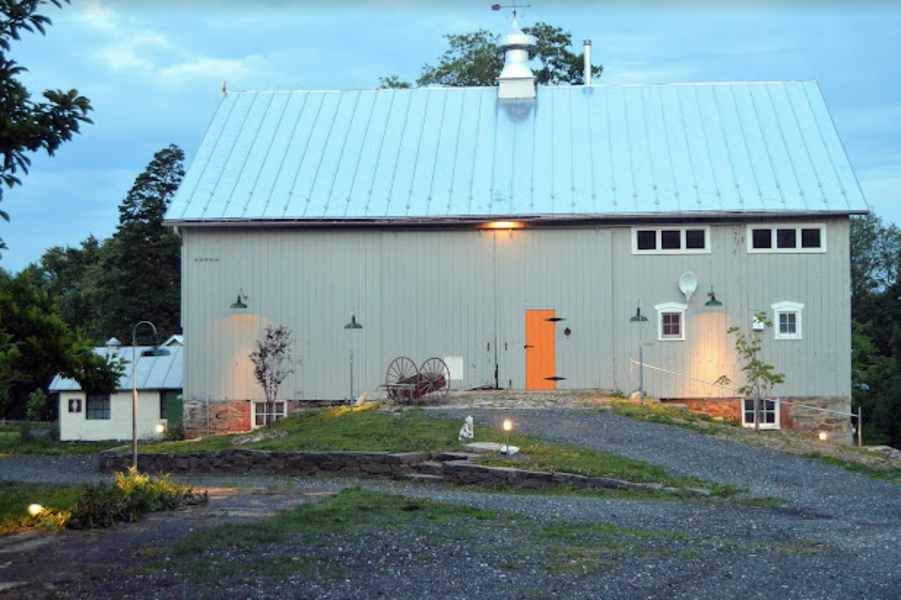 Serving nonprofits
Serving nonprofitsAs a volunteer serving on the boards of two Baltimore-area literary nonprofits, I work to help spread awareness of literary opportunities for other writers.
Good Contrivance Farm's Writing Retreats provides low-cost space for writers who would like concentrated time and solitude to work on their craft. The farm property, in Carroll County, also hosts several craft talks through the warmer months, giving the literary community a space to gather and exchange knowledge and ideas.
The Baltimore Review publishes an online journal four times a year and compiles those into a single annual print journal. My service with Baltimore Review includes helping find judges for its contests, helping to make decisions about submissions, recommending intern candidates, proofreading, writing blog posts, and other tasks.
-
 "This is my art form."
"This is my art form."Baltimore's literary and artistic communities help make the city its dynamic, creative self. For the magazine BmoreArt, I had the pleasure in 2018 of writing a profile about Ed Berlin, then with his wife Ann, owner of the Ivy Bookshop. Since the Berlins showed that Baltimore would support an independent general interest bookstore, several others have opened throughout the city.
-
Thank God We Are Always Surprised: a keynote for the Maryland State Arts Council
When the Maryland State Arts Council invited me to give the keynote for its annual awards celebration, the email arrived at the same time as the news that a bomb had gone off at the Boston Marathon. The timing of these two events led to a ten-minute keynote talk that speaks to the value of art in times of violence.
Interviews and craft essays
By sharing ideas about craft and literary art via interviews and craft essays, I'm engaging in conversations that improve my thinking about my work and, I hope, help others with their own understanding.
-
 On Method Writing: an interview conducted by Cila Warncke
On Method Writing: an interview conducted by Cila WarnckeQ: How do you know when to stop experiencing and start writing?
A: It’s always time to sit down and start writing.I invite you to read the full interview in which Cila Warncke and I talk about the relationship of writing and method acting, how to use tactile experience in literary writing, and my reading recommendations for writers.
-
 A Writer's Insight
A Writer's InsightQ: You reference your work history as a sports journalist and newsroom reporter. In what ways does journalism and reporting influence your approach to memoir and personal essay?
A: I am interested in the world. I do want to know about other people. I do want to care about them and tell their stories. But I have to figure it out, as a person writing memoir, how to do both at the same time. I think all of my nonfiction work is always informed by seeking a balance of memoir and literary journalism.I invite you to read this essay, published by The Southern Review, concerning my award-winning essay, "Answer When You Can."
-
 Q& A with local writer: Baltimore Fishbowl
Q& A with local writer: Baltimore FishbowlQ: How did you get so comfortable in the 19th century? Do you have to research details continually? What’s the process?
A: Never ending. For this novel, the research lasted until I hit the send button and mailed it to the publisher.In this conversation with author and acclaimed memoirist Marion Winik, I talk about the craft and art required to write a novel set in the 19th-century and based on the life of a real person.
-
 The Vein of Jade: Restraint in Nonfiction
The Vein of Jade: Restraint in NonfictionInspired by the third-century Chinese Art of Writing: Lu Chi's Wen Fu (translated by Sam Hamill), I explore showing restraint in works of nonfiction as opposed to telling everything up front. Norman Maclean's classic book Young Men and Fire becomes my example in this short essay, which you may read by clicking here.
-
 Me, Myself, I: Idiosyncrasy and Structure in Nonfiction
Me, Myself, I: Idiosyncrasy and Structure in NonfictionIn this essay, I explore the ways we can consider the essence of our subjects in nonfiction to find whatever structure will best contain that essence. Rather than work with received structures, we can rely on our own idiosyncratic approaches to literary art to create the best structures for our work.
"Subject matter suggests a shape, yes, but shape matters less than essence. Shape is artifice, a way to get at essence. Shape can be a product of my mind at work."
I invite you to read the entire essay, published by TriQuarterly Magazine out of Northwestern University, by clicking here.





